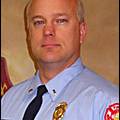The main reason to ventilate the hazmat scene is to reduce the risk associated with entering immediately dangerous to life and health atmospheres.
In the April edition of Firehouse Magazine an article entitled "Tactical Ventilation" explored several considerations for ventilating hazmat atmospheres. The main idea is to reduce the risk associated with entering immediately dangerous to life and health (IDLH) atmospheres for hazmat personnel. By ridding the area of flammable, toxic, and/or corrosive vapors and gases there is less chance of things going wrong for responders. In this way, safe and proper ventilation can become a risk management practice (see Image 1).
Some other advantages of ventilation include:
- Ventilating a confined space or room can also allow for better vision which will serve to avoid slips, trips, and falls. Vision in a Level A suit is already compromised and working inside a gas cloud is extremely risky. Better vision allows for avoiding obstacles that impede safe movement.
- Less damage to monitoring instruments. It is a fact that corrosive vapors can consume expensive and intricate air monitoring instruments in a matter of minutes as a result of extreme corrosive, both acidic and caustic, exposures. By avoiding these types of environments responders can save the needless, premature waste of $200 to $400 sensors.
- Consideration of a lesser level of personal protection equipment (PPE). Level A would be the only possible ensemble if entering an anhydrous ammonia vapor cloud, but if the ammonia cloud was removed, Level B protection may be adequate. Ventilation also removes the need for aluminized or flashover-covers to protect for flammability hazards.
- Reductions of contaminate levels may allow for quicker resolution of the emergency. Ventilation may lower the airborne contaminant level to below threshold limit values (TLV's) and allow for on-site personnel to assist in mitigating the incident. All of this depends on comprehensive and proper air monitoring practices in order to make safe decisions.
As can also be read in the article, there are several precautions to consider before using the ventilation technique. They are:
- Consider where the contaminated atmosphere will be sent before ventilating. Responders need to assure that they do not make the situation worse by sending unwanted vapors and gases somewhere else (see Image 2).
- Consider how the exhaust openings will be made before ventilating. Responders need to be well versed in ventilation techniques and equipment. Positive pressure ventilation (PPV) is a well-known technique in the fire service and it also can be applied in hazmat response. PPV can be employed with powered blowers, but with precautions. Most blowers can be ignition sources so adequate precautions, including air monitoring, needs to be conducted before operating blowers. (see Image 3).
- Consider where the blowers need to be set-up to effectively ventilate. Responders need to communicate the needed measures to properly ventilate and place blowers where they are most effective.
- Consider how to safely start the blowers. Responders need to start blowers in safe areas. Consider upwind locations, utilization of extension tubing for the blower, and proper air monitoring in the area of the blower before starting operations (see Image 4).
- Consider controlling the ventilation rate. Responders need to consider personal exposure levels that are sent downwind and strive to avoid IDLH levels.
- Consider ventilation to create a "micro-climate." Responders can create well-ventilated areas for working areas, both inside and outside, to lower risk. Properly deployed blowers can increase vision especially around leak mitigation areas (see Imageo 5).
- Ventilation is a mainstay task in confined space activities and even for confined space emergency responses. Along with effective problem solving skills and careful risk management practices, proper ventilation can also greatly assist hazmat responses. Ventilating hazmat atmospheres can be completed safely with proper considerations.
DAVID PETERSON, a Firehouse.com Contributing Editor, is a 28-year fire service veteran who serves as a lieutenant and training officer in Madison, WI, and as the training coordinator for the department's regional Level A Hazmat team. David founded the Wisconsin Association of Hazardous Materials Responders, Inc. and teaches, presents, and authors articles on a wide variety of fire and hazmat topics. David is also a National Fire Academy instructor of chemistry and a Master Instructor for the International Association of Fire Fighters HazMat and Terrorism training programs. To read David's complete biography and view his archived articles, click here. You can reach David by e-mail at [email protected].
About the Author

David F. Peterson
David F. Peterson, MS, EFO, is a 35-year veteran of the fire service and a retired Wisconsin fire chief. He is currently a fire training coordinator for Blackhawk Technical College in Janesville, WI. Peterson has served as a company officer, training officer, hazmat team leader, chief officer and incident commander. He is a past board member for the Wisconsin State Fire Chiefs Association, a national presenter on fire service and hazmat topics, and he founded the Wisconsin Association of Hazardous Materials Responders in 1992. Peterson has a master’s degree in executive fire leadership and disaster preparedness from Grand Canyon University and a bachelor’s degree in fire service management from the University of Southern Illinois. He is also a graduate of the National Fire Academy’s Executive Fire Officer Program. He is a principal partner of White Helmet Innovations, LLC.